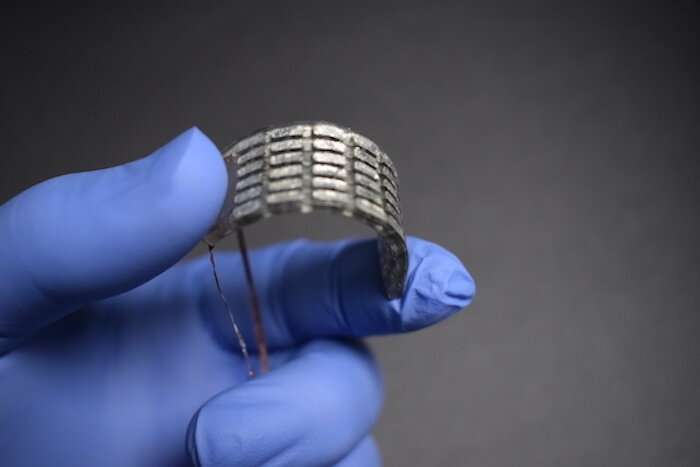Team develops mechanism to control actuation, cooling and energy conversion for soft robotics

The shape memory polymers known as liquid crystal elastomers (LCEs) are increasingly popular for uses in soft robotics, haptics, and wearable computing. Functioning as actuators, they can allow materials to contract, expand, change shape, and perform like biological muscles do.
Because the action is controlled through heating and passive cooling, efforts to speed up these processes and increase energy efficiency are critical to advancing the work.
A multidisciplinary team of researchers from Carnegie Mellon University's Department of Mechanical Engineering, Human-Computer Interaction Institute, and Robotics Institute sought to tackle this challenge by combining LCEs with a thermoelectric device (TED).
The collaborators developed a soft, flexible mechanism capable of electrically controlled actuation, active cooling, and thermal-to-electrical energy conversion. They also introduced a new manufacturing process for stretchable and bendable thermoelectric devices using 3D printing. The findings were published in the journal Advanced Materials.
The LCE-TED mechanism functions as a transducer—an electrical device that converts one form of energy into another. A thin layer of TED contains semiconductors embedded within a 3D printed elastomer matrix. It is wired with eutectic gallium-indium (EGaIn) liquid metal connections.
TEDs operate with dual functionality as both heaters and coolers in one mode and energy harvesters in the other. Because the layer is covered with LCEs on both sides, the TED can alternately heat and cool the LCE layers. In addition, it can harvest energy from the changes in temperature.
"The ability to recover energy from residual heat and thermal gradients could contribute to improved energy efficiency and longevity of the host electronic device or robotic system," said Carmel Majidi, a professor of mechanical engineering who directs the Soft Machines Lab.
Soft robotics demonstrations revealed advantages of the LCE-TED transducers for use in practical applications: fast and accurate tracking due to active cooling; autonomous, "smart" maneuvering of a two-limbed walker toward a heat source; and regenerative energy harvesting.
"This demonstrates the potential for creating soft robotic systems that can harvest some of the electrical power they need from energy in the environment around them," said Mason Zadan, a Ph.D. student and the lead author of the study.
Additional research will seek to integrate the transducers into the limbs of soft robots to more fully realize LCE-TED's potential. Another aspect of the work will aim to further develop the energy harvesting and controls capabilities using untethered soft robotic platforms.
More information: Mason Zadan et al, Liquid Crystal Elastomer with Integrated Soft Thermoelectrics for Shape Memory Actuation and Energy Harvesting, Advanced Materials (2022). DOI: 10.1002/adma.202200857















